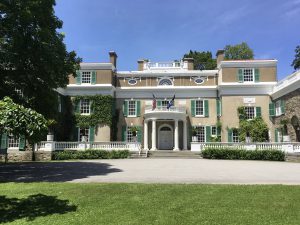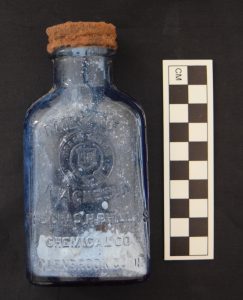This summer, I was part of an archaeology team that worked on an excavation project of dump sites at the Home of Franklin D. Roosevelt National Park in Hyde Park, NY. The project was led by Professor April Beisaw and my fellow team members included other Vassar students– Jonathan Alperstein, Kelly Bernatzky, Ray Cagnetta, Pedro Millard, and David Sparks. Our job was to excavate the site and analyze the artifacts and data to determine the origin and time period of the dump. Preliminary dating of the sites was roughly in the middle of the twentieth century and many of the artifacts collected were vessel glass, metal fragments, ceramics, windowpane fragments, and an array of other things.
This project is three years long and I joined on the second year after one site was already excavated and we were beginning to excavate the second site. As someone who has never done archaeology before, this project was very beneficial because I got to jump into the uncompleted lab work for the first site, Riverside site, but I also got hands-on experience at a dig site with the second site, the Woods site. On top of my history focused work, I gained valuable practice and exposure about delineating a site, excavating, and surveying the land while at the National Park. Back at the lab, I learned how to wash, prepare, and rebag artifacts, inventory, catalog, research, and draft report pieces.
As a history major, my specific specialization on the project was determining the dating and history of the artifacts and sites. I spent a lot of time identifying and researching artifacts using maker’s marks, internet searches, china patterns, books, and collector’s websites. Some artifacts were very diagnostic, like Milk of Magnesia bottles, while other items were more frustrating, like ferrous nails or tiny paper fragments. The project is ongoing, so I cannot yet write conclusively about a more specific date for the site, but many of the date intersections of the artifacts from the Woods site are in the mid-to-late 1930s.
In addition to field and lab work, the team got to attend a tour of the Roosevelt Springwood Mansion for context. Even on a tourist endeavor, we found valuable information regarding our project, a china piece in the parlor matched one of our artifacts, allowing us to figure out the pattern and history. David and I also had the opportunity to conduct extra research at the FDR Presidential Library and Archives in regards to the history of the land. Even though our artifacts and research so far do not point directly to FDR or his immediate family, the archives allow us more access to information about his tenants, servants, workers, extended family members, and neighbors who also used the land.
This summer experience has allowed me to explore research in a very interdisciplinary manner; I applied many of my history skills while at the same time learning about archaeology and anthropology. I am grateful to have the opportunity to get hands-on experience and skills that I will carry on to other research opportunities and I look forward to continuing this project in the fall.



